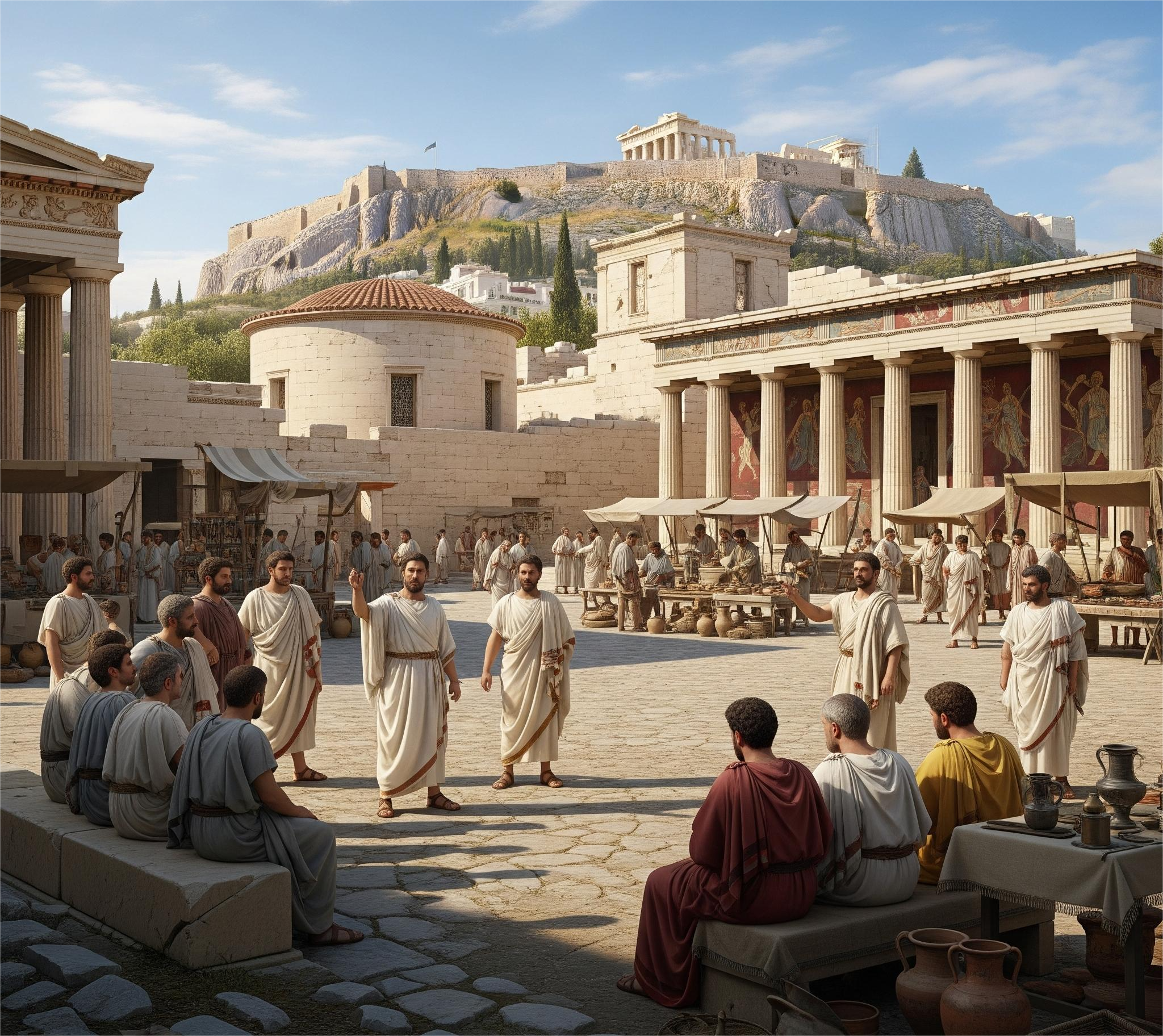Nestled beneath the shadow of the Acropolis, the Athenian Agora served as the beating heart of classical Athens—a vibrant open space that was far more than just a marketplace. It was here that democracy was practiced, philosophical schools flourished, and citizens debated everything from trade to justice. To understand ancient Athenian democracy, one must understand the Agora—not just as a physical location, but as a symbol of civic life.
What Was the Agora?
In Greek, agora means “gathering place” or “assembly.” In practice, it was a large open-air plaza, surrounded by stoas (covered colonnades), temples, administrative buildings, and shops. While agoras existed in many Greek city-states, Athens' Agora was exceptional in its scale and function.
Located northwest of the Acropolis, the Athenian Agora developed in the 6th century BCE and evolved into a multi-purpose space used daily by citizens for commerce, religion, governance, education, and social interaction.
Political Center: Democracy in Action
Perhaps the most defining role of the Athenian Agora was its function as the epicenter of democracy. Unlike modern representative democracies, Athenian democracy was direct—citizens voted on laws themselves rather than through elected officials.
Key political institutions within or near the Agora included:
The Bouleuterion: Home of the Boule, the 500-member council that prepared matters for the popular Assembly (Ekklesia).
The Tholos: The headquarters of the executive committee of the Boule. Members dined and slept here to be on call 24/7.
Law Courts: Large jury panels, sometimes with hundreds of citizens, convened in the Agora to hear cases. Citizens served as jurors by lot.
Public discourse and accountability were core values. Citizens gathered to listen, speak, and even hold officials to scrutiny through a practice known as ostracism—where votes could exile a powerful individual seen as a threat to democracy.
Commercial Hub: A Marketplace of Goods and Ideas
True to its origins as a marketplace, the Agora was Athens' primary commercial zone, teeming with:
Merchants and artisans selling everything from olives, pottery, and textiles to fresh produce.
Workshops and stalls lining the perimeter, where metalworkers, cobblers, and sculptors plied their trades.
Currency exchanges and weights inspectors who ensured fair trade practices under the supervision of civic officials.
This economic vibrancy reflected Athens’ role as a Mediterranean powerhouse, drawing traders from across the ancient world. But unlike modern shopping malls, the Agora also offered philosophical goods—intellectual debates, storytelling, and performances often spilled out into public view.
Intellectual and Philosophical Center
The Agora wasn’t just where people bought goods—it’s where they exchanged ideas.
Socrates, Athens’ most famous philosopher, roamed the Agora questioning passersby and engaging in dialectic discussions.
Plato’s and Aristotle’s students likely frequented the area, where teaching often occurred outdoors in shaded stoas.
Sophists and rhetoricians offered lessons in persuasion and logic to aspiring politicians and orators.
This open intellectual environment, mixed with democratic freedom of speech (parrhesia), fostered the birth of Western philosophy—with the Agora as its classroom.
Social and Religious Life
The Agora also played a central role in social and religious activities:
Temples and altars, including those of Hephaestus, Zeus, and Apollo, were scattered throughout the space.
Processions and festivals, such as the Panathenaic Festival, passed through the Agora.
Fountains and public buildings served as gathering spots where citizens could discuss news, gossip, and policy.
It was a space of inclusion and exclusion—where male citizens enjoyed full rights, while women, slaves, and metics (resident foreigners) had limited access to political life but still participated in the Agora’s commercial and religious aspects.
Architectural Highlights of the Agora
Stoa of Attalos: A grand colonnaded structure rebuilt in modern times, it originally offered shelter for merchants and now houses the Museum of the Ancient Agora.
Temple of Hephaestus (Theseion): One of the best-preserved temples in Greece, overlooking the Agora.
Altar of the Twelve Gods: A central point used as a mile marker and a place of asylum.
These buildings reflect the Agora’s role as both civic utility and aesthetic showcase, combining functionality with beauty.
Legacy: A Blueprint for Public Life
The Athenian Agora’s influence echoes into modern times:
Modern town squares and parliaments are rooted in the Agora’s blend of commerce and civic life.
The Agora serves as a model for public engagement, transparency, and direct political participation.
In archaeology and political theory, it stands as a reminder that democracy is not just a system—it’s a lived, public experience.







